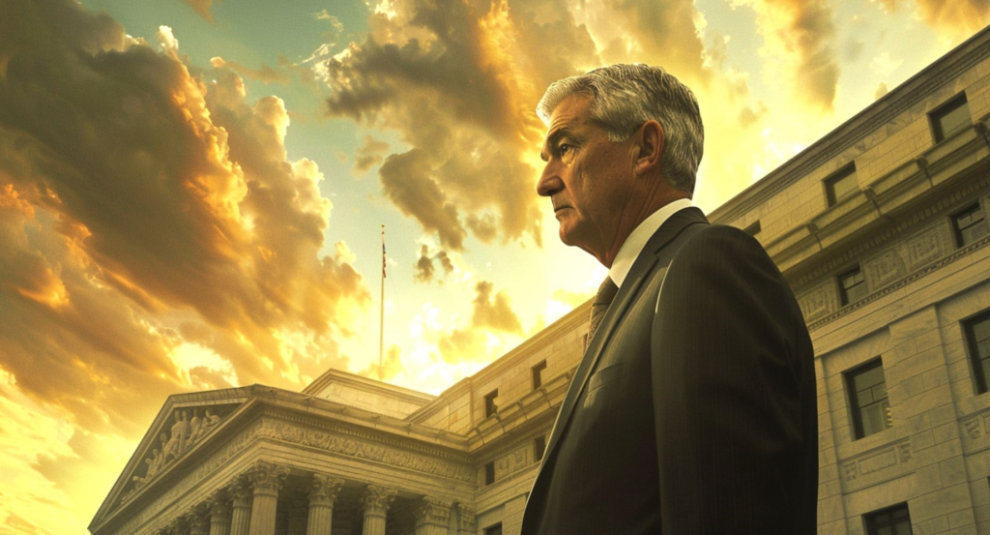As Wall Street gears up for Federal Reserve Chair Jerome Powell‘s press conference on Wednesday at 2:30 p.m. ET, all eyes are on his messaging rather than the central bank’s policy action.
The Fed is widely expected to hold interest rates steady at 4.25%-4.50% for a third consecutive meeting, but what Powell says could move markets.
Tariffs, Trump, Trade: A Shifting Backdrop
Market participants are closely watching for Powell’s tone on the recent trade-related developments. President Donald Trump‘s announcement in April of new tariffs has stirred speculation about potential inflationary pressures and global economic retaliation.
The Fed chair may address how these policies could disrupt the inflation trajectory or weigh on consumer sentiment, which has shown signs of softening.
The first quarter of 2025 brought a puzzling contrast: a strong labor market and solid corporate earnings alongside a negative GDP print, driven largely by a surge in imports.
Powell is likely to clarify whether this contraction is more of a technical than cyclical factor, a point that may be emphasized to ease market concerns.
Trump’s Shadow Over The Fed
Powell is also navigating the increasingly loud political pressure from Trump, who last month called him “too late and wrong” and hinted at removing him—though later walked back those comments.
While markets are discounting the possibility of a premature dismissal—Kalshi betting odds show only a 13% chance Powell is fired by the end of 2025, down from 30% last month—the long game is telling.
Odds of Powell being reappointed in May 2026 are minimal, sitting at just 4%. Former Fed Governor Kevin Warsh currently leads the betting boards with a 58% chance of succeeding him, suggesting markets are preparing for a policy shift in the post-Powell era.
What Powell Is Most Likely To Say On Wednesday: Betting Markets Weigh In
Kalshi data provides a statistical lens into what themes are likely to dominate Powell’s speech.
According to bettors, Powell is almost guaranteed to mention “tariff” (98% chance), underscoring how central the trade issue has become in economic discussions.
Terms like “Good Afternoon” (97%), “energy” (95%), “expectation” (95%) and “balance sheet” (91%) also have high odds of appearing.
Also likely to feature prominently are terms that hint at cautious Fed messaging: “balance of risk” (87%), “recession” (86%), and “restrictive” (84%).
The 64% probability of him mentioning “China” ties into both the trade narrative and broader global economic uncertainties.
It’s highly unlikely—just a 12% chance—that Powell will directly mention the President by name, highlighting the Fed Chair’s consistent effort to maintain political neutrality and avoid inflaming tensions with the White House.
A $100 bet on Powell mentioning “China” would return $154, while the same wager on him saying “Trump” would yield a staggering $784.
It’s also unlikely that Powell will use the phrase “trade war” directly, as he tends to favor more measured, academic language such as “trade tensions” or “trade uncertainty.” A $100 bet on him saying “trade war” would return a hefty $892.
Words You’re Likely To Hear From Powell (Odds ≥ 50%)
| Term | Kalshi Odds |
|---|---|
| Tariff | 98% |
| Good Afternoon | 97% |
| Energy | 95% |
| Expectation | 95% |
| Balance sheet | 91% |
| Balance of risk | 87% |
| Recession | 86% |
| Restrictive | 84% |
| China | 64% |
| Credit | 58% |
Unlikely Terms In Powell’s Speech (Odds < 50%)
| Term | Kalshi Odds |
|---|---|
| Projection | 40% |
| QT / Quantitative Tightening | 39% |
| Median | 38% |
| Real wage | 35% |
| Consumer confidence | 44% |
| Yield curve | 27% |
| Dot plot | 23% |
| Gas / Gasoline / Natural Gas | 19% |
| Michigan | 18% |
| Crypto / Cryptocurrency | 17% |
| Default | 16% |
| Fuel | 15% |
| R*/R-star / R star | 13% |
| Trump | 12% |
| Soft landing | 12% |
| Trade war | 10% |
| Bitcoin | 10% |
| EU / European Union | 10% |
| Egg | 6% |
| Fort Knox | 3% |
What Powell Said In Past Conferences
“Expectation” stood out as the most frequently used term, mentioned 18 times in March and nine times in January, highlighting the central bank’s focus on consumer forward-looking inflation perceptions.
“Balance sheet” was also a recurring theme, with nine mentions in March, up from just two in January.
Terms like “median” and “projection,” which didn’t appear in January, were mentioned seven and six times, respectively, in March, as that meeting showed the Federal Reserve’s Summary of Economic Projections with the dot plot.
“Recession” was cited four times in March, reflecting increased market sensitivity to downside risks, while “QT” (Quantitative Tightening) appeared twice.
The term “restrictive” dropped sharply from nine uses in January to just one in March. References to “China,” “crypto,” and “Bitcoin” were absent in March, while they appeared in January.
| Term | March Count | January Count |
|---|---|---|
| Expectation | 18 | 9 |
| Balance sheet | 9 | 2 |
| Median | 7 | 0 |
| Projection | 6 | 0 |
| Recession | 4 | 0 |
| Balance of risk | 2 | 2 |
| QT / Quantitative Tightening | 2 | 1 |
| Good Afternoon | 1 | 1 |
| Energy | 1 | 1 |
| Restrictive | 1 | 9 |
| Michigan | 1 | 0 |
| China | 0 | 1 |
| Crypto / Cryptocurrency | 0 | 3 |
| Bitcoin | 0 | 1 |
Read now:
Image created using artificial intelligence via Midjourney.


Add Comment